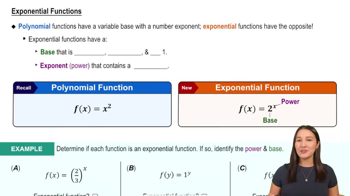Table of contents
- 0. Functions7h 52m
- Introduction to Functions16m
- Piecewise Functions10m
- Properties of Functions9m
- Common Functions1h 8m
- Transformations5m
- Combining Functions27m
- Exponent rules32m
- Exponential Functions28m
- Logarithmic Functions24m
- Properties of Logarithms34m
- Exponential & Logarithmic Equations35m
- Introduction to Trigonometric Functions38m
- Graphs of Trigonometric Functions44m
- Trigonometric Identities47m
- Inverse Trigonometric Functions48m
- 1. Limits and Continuity2h 2m
- 2. Intro to Derivatives1h 33m
- 3. Techniques of Differentiation3h 18m
- 4. Applications of Derivatives2h 38m
- 5. Graphical Applications of Derivatives6h 2m
- 6. Derivatives of Inverse, Exponential, & Logarithmic Functions2h 37m
- 7. Antiderivatives & Indefinite Integrals1h 26m
- 8. Definite Integrals4h 44m
- 9. Graphical Applications of Integrals2h 27m
- 10. Physics Applications of Integrals 2h 22m
0. Functions
Properties of Functions
Problem 1.16
Textbook Question
In Exercises 9–16, determine whether the function is even, odd, or neither.
𝔂 = x cos x
 Verified step by step guidance
Verified step by step guidance1
To determine if a function is even, odd, or neither, we need to analyze the function's symmetry properties. A function f(x) is even if f(-x) = f(x) for all x in the domain, and it is odd if f(-x) = -f(x) for all x in the domain.
Start by substituting -x into the function y = x cos(x). This gives us y(-x) = (-x) cos(-x).
Recall that the cosine function is even, meaning cos(-x) = cos(x). Therefore, y(-x) = (-x) cos(x).
Now, compare y(-x) = (-x) cos(x) with the original function y = x cos(x). Notice that y(-x) = -y(x), which satisfies the condition for the function to be odd.
Since y(-x) = -y(x), the function y = x cos(x) is classified as an odd function.
 Verified video answer for a similar problem:
Verified video answer for a similar problem:This video solution was recommended by our tutors as helpful for the problem above
Video duration:
2mPlay a video:
Was this helpful?
Key Concepts
Here are the essential concepts you must grasp in order to answer the question correctly.
Even Functions
A function is considered even if it satisfies the condition f(-x) = f(x) for all x in its domain. This means that the graph of the function is symmetric with respect to the y-axis. For example, the function f(x) = x² is even because f(-x) = (-x)² = x².
Recommended video:

Exponential Functions
Odd Functions
A function is classified as odd if it meets the condition f(-x) = -f(x) for all x in its domain. This indicates that the graph of the function is symmetric with respect to the origin. An example of an odd function is f(x) = x³, as f(-x) = (-x)³ = -x³.
Recommended video:

Properties of Functions
Function Analysis
Function analysis involves evaluating the properties of a function, such as its symmetry, continuity, and limits. In the context of determining if a function is even, odd, or neither, one typically substitutes -x into the function and compares the result to f(x) and -f(x). This analysis is crucial for understanding the behavior of functions in calculus.
Recommended video:

Derivatives Applied To Velocity

 6:21m
6:21mWatch next
Master Properties of Functions with a bite sized video explanation from Nick
Start learningRelated Videos
Related Practice

